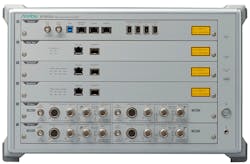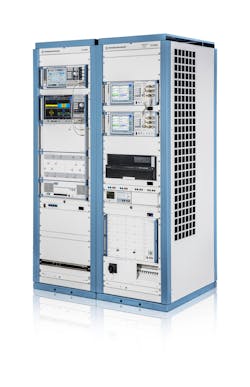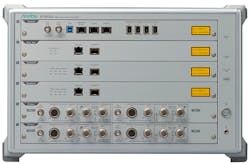Conformance and regulatory issues must be addressed in the rollout of any technology such as 5G. And effective development and deployment strategies require cooperative efforts among component manufacturers, test providers, industry organizations, standards and certification bodies, and universities and research institutions.
Several industry experts who provided input for our recent report on 5G technology1 commented on efforts in conjunction with other companies, universities, government agencies, and standards bodies.
“Our first priority when we started our 5G program over five years ago was to build collaborations with the market leaders from commercial, government, and academic institutions,” said Roger Nichols, 5G program manager, Keysight Technologies Inc. “As of today, we have over 35 of these collaborations around the globe, across different technologies, and across the ecosystem.” That ecosystem, he said, includes operators like Docomo, modem companies like Qualcomm and base-station companies like Nokia; universities including the University of California at both Berkeley and San Diego, the University of Bristol, Southeast University in Nanjing, and NYU Wireless; and standards bodies like 3GPP, CTIA, and GCF. “These have been rich engagements with mutual benefit plus helping drive the overall 5G commercialization across the ecosystem” he said.
Rohde & Schwarz has partnered with several 5G development groups, including the 5G Lab Germany, hosted and managed by the Technical University of Dresden, according to Andreas Roessler, technology manager, Rohde & Schwarz USA. In addition, “Since the early days of 5G, Rohde & Schwarz has been partnering with the Fraunhofer Heinrich-Hertz Institute (HHI) of Berlin on channel-sounding measurement campaigns for frequencies up to 300 GHz, including the measurements of the angle-of-arrival (AoA).”
Roessler also said Rohde & Schwarz recognizes the importance of industry cooperation in meeting the demand for end-to-end system optimization in new and emerging vertical markets, noting that the company was early to join the 5G Alliance for Connected Industries and Automation (5G ACIA) and the 5G Automotive Association (5GAA). “In both organizations, Rohde & Schwarz provides its expertise from a test and measurement perspective and actively contributes to the related working groups,” he said.
According to Alejandro Buritica, senior marketing manager, Semiconductor Solutions, National Instruments, “Collaboration with industry, standards bodies, and research institutions is key to realizing successful 5G deployment and adoption. We continue to invest and work together with top researchers on core measurement challenges.”
Added Buritica, “With regards to standards bodies, we actively participate in key RAN 1 and RAN 4 3GPP meetings to make sure we stay abreast of upcoming test needs. We have a good relationship with NIST on test and calibration methodologies for new 5G device types.”
He continued, “In terms of academic research, NI is involved with many nonpublic collaborations, but one public example of a 5G collaboration is with the University of Warwick. They have been using NI’s mmWave Transceiver System as well as NI’s 5G NR test UE to research various topics related to vehicular communications. Also, the University of Bristol and Lund University partnered with NI to demonstrate world records in 5G wireless spectral efficiency using massive MIMO.”
NI has also collaborated with several companies. “For example, we have worked very closely with semiconductor industry leaders Qorvo and Analog Devices to help them create extensive test solutions for new 5G parts,” said Buritica. “We also cooperated with Tokyo Electron, FormFactor, and Reid-Ashman to demonstrate a 5G mmWave semiconductor wafer-probe test solution that helps reduce risk and cost for validation and production test of 5G mmWave ICs.”
In addition, he said, NI introduced its 5G New Radio Test UE earlier this year. It is a fully Release 15 NSA-compliant UE that can attach to commercial gNB hardware. He added that NI has also partnered with Spirent on a 5G NR gNB solution that, combined with other Spirent products, can create a full end-to-end 5G network. “Complete with logging capabilities, this end-to-end network offers valuable validation capabilities for 5G equipment,” he said.
Additional collaborative efforts include Spirent’s work the UK Government-sponsored 5GIC (5G Innovation Center) at Surrey University. “This multivendor environment fosters innovation around 5G industry verticals,” said Stephen Douglas, head of 5G practice, Spirent. “Spirent 5G traffic emulation is used to make the facility the largest capacity representative 5G test network for research, innovation, and development in the world.”
Spirent is also working with the Warwick Manufacturing Group, which Douglas described as an academic department providing research, education, and knowledge transfer in engineering, manufacturing, and technology. “WMG is leading the UK research around 5G for the future of autonomous vehicles and Industry 4.0,” he said. “Spirent 5G digital-twin emulation solutions are helping turn the test beds into representative and flexible 5G network testing environments, allowing automotive and industry partners to research and innovate.”
Recent efforts of Marvin Test Solutions with respect to 5G test have centered on a mmWave/5G semiconductor production test system capable of delivering 50-GHz signals to a DUT, according to Jon Semancik, director of marketing, Marvin Test Solutions. He said that for production test applications requiring integration with an automated handler, the TS-960e-5G is available with an inTEST manipulator, which provides precise positioning of the test head and the flexibility to interface to automated probers and device handlers, adding that the device interface board (DIB)/receiver interface is designed to be compatible with virtually any device handler. He noted that available digital vector conversion tools support standard ASCII, WGL, STIL, VCD, eVCD, and ATP vector formats. In addition, he said, “MTS is collaborating with leading VNA instrumentation suppliers, including Keysight and Rhode & Schwarz, to develop open-platform solutions that best fit customer’s requirements and price-points.”
Compliance and regulatory news
The MT8000A covers the key frequency bands used by the first 5G services, such as the sub-6-GHz band (FR1) frequencies of 2.5 GHz, 3.5 GHz, and 4.5 GHz as well as the mmWave band (FR2) frequencies of 28 GHz and 39 GHz.
Also in October, Keysight announced that PCTEST had selected Keysight’s 5G network emulation solutions to address testing of critical regulatory requirements mandated by the FCC for 5G mobile devices. Keysight said its end-to-end 5G test solutions enable PCTEST to characterize the performance of a 5G mmWave device in an over-the-air (OTA) test environment and certify the device according to the FCC EMC and SAR requirements for measurement of power levels, signal strength, and emissions produced by a 5G mobile device. Keysight said it combines the company’s 5G network emulation solutions with its compact antenna test range (CATR) chambers to support regulatory radio- frequency (RF) testing of 5G mobile devices in both conducted and radiated test environments across the sub-6-GHz (FR1) and mmWave (FR2) spectrums.
And in November, Rohde & Schwarz announced that The Global Certification Forum (GCF) and the PTCRB certification organization have accepted first test case validations in various FR1 and LTE band combinations using its new R&S TS8980FTA-3A 5G RF conformance test system. The company said the R&S TS8980FTA-3A is the latest version of a family of RF conformance test systems supporting mobile technologies all the way from 2G to 5G on one platform.
Myriad applications
Vendors’ efforts have been opening up a range of applications. Buritica at NI said customers have been using NI’s PXI platform to set up highly automated test benches for characterization of RF front-ends in both FR1 and FR2.
“They are taking advantage of our mmWave heads with built-in, calibrated switching to test new device types like multichannel beamformers with dual polarization without having to maintain complicated switching schemes,” he said. “Also, we’ve helped significantly reduce the time it takes to run full 3D-spatial OTA tests of new mmWave antenna-in-package (AiP) devices using our novel approach to OTA test.”
Buritica elaborated on OTA, saying, “To help engineers in charge of mmWave OTA characterization and validation test of AiP beamforming devices reduce test times without compromising accuracy, NI developed the mmWave OTA Validation Test reference architecture, which takes a platform-level approach that integrates NI’s real-time motion control, data-acquisition, and PXI triggering and synchronization to take fast, high-bandwidth RF measurements synchronized with the instantaneous ( ) coordinates of the positioner’s motors,” he said. “Unlike traditional OTA test solutions, NI’s approach moves the DUT in a smooth and continuous motion across the 3D space while the RF engine takes rapid measurements. This eliminates the time waste of moving discretely from point to point.”
Nichols at Keysight also commented on OTA test, noting that 100% of mmWave test cases are OTA. “OTA testing is not unique to 5G, but there are parts that are particularly novel,” he said, citing the directional nature of the radio transmission. “The concept of managing a beam that points from the transmitter to the receiver and focusing the receiver on that beam is new to 5G,” he said. “What makes this extraordinary is that one of the radio transceivers involved is mobile and can be moved to any location and any orientation with the radio system making every possible effort to maintain the link. Testing this involves a complex set of measurements that validate the flexibility of the spherical coverage of the UE for both Tx and Rx—and all of these are calibrated over-the-air measurements. The standards for managing mobility for mmWave are not yet complete, so it is easy to assume that this will continue to present challenges.”
Nichols also commented on the company’s FieldFox portable analyzer for 5G, satellite-communications, signal-monitoring, and electronic-warfare applications. “Complex beam sweeping technologies used with radar and EW systems, as well as with 5G control channels, will require wider bandwidths and real-time spectrum-analysis tools to capture these intermittent and elusive signals,” he said. “FieldFox can connect to 89600 VSA software to demodulate 5G NR and LTE-A signals up to 100 MHz or easily switch to over-the-air (OTA) measurements for 5G and 4G LTE to verify gNB performance.”
Roessler at Rohde & Schwarz noted that 5G requires an increasing amount of OTA testing. Rohde & Schwarz launched three new OTA solutions based on CATR technology: the R&S ATS800B benchtop solution, the R&S ATS800R rack solution, and the R&S ATS1800C 5G NR mmWave test chamber. “All these OTA solutions feature a high-precision CATR reflector to generate a big useable measurement area (the so-called quiet zone, QZ) in a very compact setup,” he said. “The R&S ATS800B and R&S ATS800R provide a 20-cm QZ whereas the R&S ATS1800C offers a 30-cm QZ, which complies with 3GPP RF conformance test requirements. The portable compact chamber solution provides very high shielding efficiency and features a 3D positioner that can even move more heavy devices up to 8 kg.”
Douglas at Spirent emphasized digital-twin applications. “The 5G digital twin is an emulated software replica of the physical network, allowing continuous prototyping, modeling, and research,” he said. “As 5G moves us from being a physical network to a living system, the digital twin is an ideal solution. The digital twin consists of multiple emulation, traffic, and signal-generation functions working in harmony to provide a virtual software version of the 5G network.”
Investment protection
The move to 5G has implications for investment protection. Adnan Khan, senior business development manager for wireless products at Anritsu, noted that the company’s existing customers can repurpose their 4G assets towards 5G, using, for example, Anritsu’s MT8821C radio communication analyzer as an LTE anchor. “This also gives customers the option of using a GUI they are familiar with for testing,” he said. “Also, for conformance systems, Anritsu is able to use many 4G solutions in 5G applications.”
Nichols at Keysight noted that in some cases equipment used to test 4G can test 5G, possibly with software updates. In other cases, test equipment must be completely rebuilt to address mmWave frequencies and OTA requirements. Keysight, he said, works on line extensions as well as commercial technology refresh programs. “Of course, we have to ensure that new platforms can manage the demands of not just the new technology, but also that of the legacy and of the interaction between the generations,” he said. “In the case of 5G NSA Core testing, we have evolved our test solution such that our customers can seamlessly use all 4G functionality they have been using without change. In this case, our customers’ investments are protected with 100% reusability. 5G SA core testing brings a new architecture and a new test paradigm, but even in this case we expect to be able to provide our customers with ‘fallback’ capabilities such that their validation of standalone 5G services is not conducted at the expense of 4G validation.”
Roessler at Rohde & Schwarz cited the company’s widely used R&S CMW500 platform. “The initial roll-out of 5G is based on non-standalone (NSA) mode where an LTE anchor is required for the exchange of control and signaling information,” he said. “Therefore, it was evident to Rohde & Schwarz to save our customers’ investment into the R&S CMW500 for 4G LTE testing and reuse the platform to provide this anchor functionality. The R&S CMX500 uses an advanced hardware design concept and intelligence unified web-based graphical user interface to make it the platform to test 5G for decades to come and beyond.”
Douglas at Spirent said he doesn’t see the need for 4G test and measurement diminishing in the short to medium term due to four industry trends. “First, many CSPs are aggressively building out underlay LTE-A Pro networks alongside 5G for ‘coverage and fallback’ to guarantee customers a premium experience and look to quickly close and refarm 3G,” he said. “Second, many Tier 2 CSPs will stay with 5G evolution (NSA) utilizing the 4G Core (vEPC) for a protracted period. Third, the growth of private networks will initially be via LTE evolving towards 5G from 2022 on. And fourth, in automotive, C-V2X will first harness LTE before evolving to 5G from 2022 on.” Consequently, “4G test systems will still be critical,” he said. “Customers are asking Spirent to help create a future-proof pathway for test tools to evolve to 5G as needed. To provide this pathway, Spirent has been developing many of its systems to support software-defined architectures, virtualization, and cloud-native micro-services. In addition, our recent partnership with National Instruments to use their industry leading SDR to underpin our radio test systems benefits customers from future-proofed investment.”
REFERENCE
1. Nelson, Rick, “Innovations from semiconductors to digital twins drive 5G,” EE-Evaluation Engineering, December 2019, p. 6.
About the Author

Rick Nelson
Contributing Editor
Rick is currently Contributing Technical Editor. He was Executive Editor for EE in 2011-2018. Previously he served on several publications, including EDN and Vision Systems Design, and has received awards for signed editorials from the American Society of Business Publication Editors. He began as a design engineer at General Electric and Litton Industries and earned a BSEE degree from Penn State.


